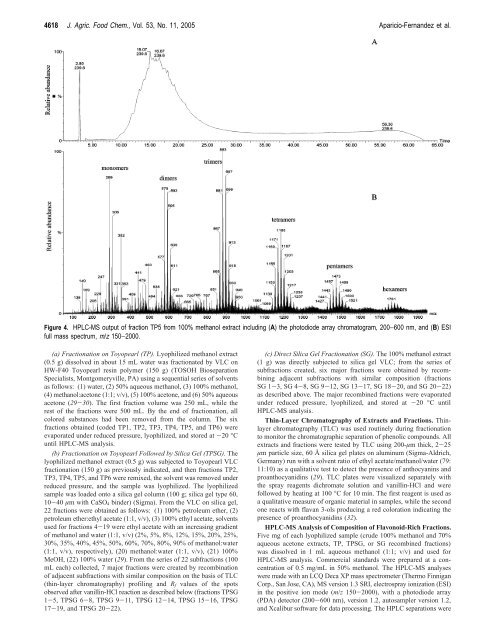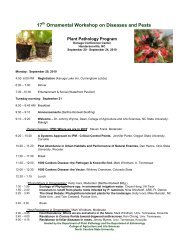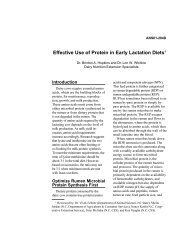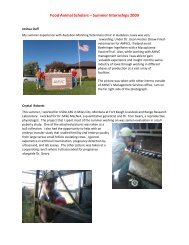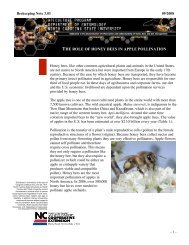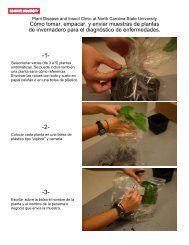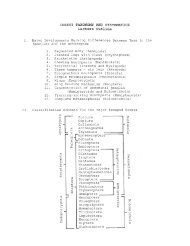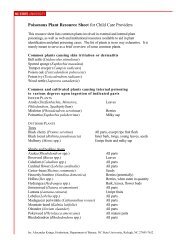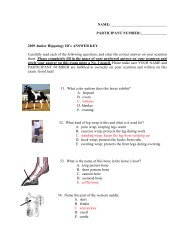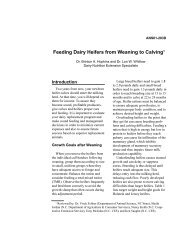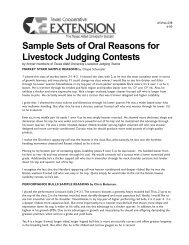Jamapa Bean (Phaseolus vulgaris L.)
Jamapa Bean (Phaseolus vulgaris L.)
Jamapa Bean (Phaseolus vulgaris L.)
You also want an ePaper? Increase the reach of your titles
YUMPU automatically turns print PDFs into web optimized ePapers that Google loves.
4618 J. Agric. Food Chem., Vol. 53, No. 11, 2005 Aparicio-Fernandez et al.<br />
Figure 4. HPLC-MS output of fraction TP5 from 100% methanol extract including (A) the photodiode array chromatogram, 200−600 nm, and (B) ESI<br />
full mass spectrum, m/z 150−2000.<br />
(a) Fractionation on Toyopearl (TP). Lyophilized methanol extract<br />
(0.5 g) dissolved in about 15 mL water was fractionated by VLC on<br />
HW-F40 Toyopearl resin polymer (150 g) (TOSOH Bioseparation<br />
Specialists, Montgomeryville, PA) using a sequential series of solvents<br />
as follows: (1) water, (2) 50% aqueous methanol, (3) 100% methanol,<br />
(4) methanol:acetone (1:1; v/v), (5) 100% acetone, and (6) 50% aqueous<br />
acetone (29-30). The first fraction volume was 250 mL, while the<br />
rest of the fractions were 500 mL. By the end of fractionation, all<br />
colored substances had been removed from the column. The six<br />
fractions obtained (coded TP1, TP2, TP3, TP4, TP5, and TP6) were<br />
evaporated under reduced pressure, lyophilized, and stored at -20 °C<br />
until HPLC-MS analysis.<br />
(b) Fractionation on Toyopearl Followed by Silica Gel (TPSG). The<br />
lyophilized methanol extract (0.5 g) was subjected to Toyopearl VLC<br />
fractionation (150 g) as previously indicated, and then fractions TP2,<br />
TP3, TP4, TP5, and TP6 were remixed, the solvent was removed under<br />
reduced pressure, and the sample was lyophilized. The lyophilized<br />
sample was loaded onto a silica gel column (100 g; silica gel type 60,<br />
10-40 µm with CaSO4 binder) (Sigma). From the VLC on silica gel,<br />
22 fractions were obtained as follows: (1) 100% petroleum ether, (2)<br />
petroleum ether:ethyl acetate (1:1, v/v), (3) 100% ethyl acetate, solvents<br />
used for fractions 4-19 were ethyl acetate with an increasing gradient<br />
of methanol and water (1:1, v/v) (2%, 5%, 8%, 12%, 15%, 20%, 25%,<br />
30%, 35%, 40%, 45%, 50%, 60%, 70%, 80%, 90% of methanol:water<br />
(1:1, v/v), respectively), (20) methanol:water (1:1, v/v), (21) 100%<br />
MeOH, (22) 100% water (29). From the series of 22 subfractions (100<br />
mL each) collected, 7 major fractions were created by recombination<br />
of adjacent subfractions with similar composition on the basis of TLC<br />
(thin-layer chromatography) profiling and Rf values of the spots<br />
observed after vanillin-HCl reaction as described below (fractions TPSG<br />
1-5, TPSG 6-8, TPSG 9-11, TPSG 12-14, TPSG 15-16, TPSG<br />
17-19, and TPSG 20-22).<br />
(c) Direct Silica Gel Fractionation (SG). The 100% methanol extract<br />
(1 g) was directly subjected to silica gel VLC; from the series of<br />
subfractions created, six major fractions were obtained by recombining<br />
adjacent subfractions with similar composition (fractions<br />
SG 1-3, SG 4-8, SG 9-12, SG 13-17, SG 18-20, and SG 20-22)<br />
as described above. The major recombined fractions were evaporated<br />
under reduced pressure, lyophilized, and stored at -20 °C until<br />
HPLC-MS analysis.<br />
Thin-Layer Chromatography of Extracts and Fractions. Thinlayer<br />
chromatography (TLC) was used routinely during fractionation<br />
to monitor the chromatographic separation of phenolic compounds. All<br />
extracts and fractions were tested by TLC using 200-µm thick, 2-25<br />
µm particle size, 60 Å silica gel plates on aluminum (Sigma-Aldrich,<br />
Germany) run with a solvent ratio of ethyl acetate/methanol/water (79:<br />
11:10) as a qualitative test to detect the presence of anthocyanins and<br />
proanthocyanidins (29). TLC plates were visualized separately with<br />
the spray reagents dichromate solution and vanillin-HCl and were<br />
followed by heating at 100 °C for 10 min. The first reagent is used as<br />
a qualitative measure of organic material in samples, while the second<br />
one reacts with flavan 3-ols producing a red coloration indicating the<br />
presence of proanthocyanidins (32).<br />
HPLC-MS Analysis of Composition of Flavonoid-Rich Fractions.<br />
Five mg of each lyophilized sample (crude 100% methanol and 70%<br />
aqueous acetone extracts, TP, TPSG, or SG recombined fractions)<br />
was dissolved in 1 mL aqueous methanol (1:1; v/v) and used for<br />
HPLC-MS analysis. Commercial standards were prepared at a concentration<br />
of 0.5 mg/mL in 50% methanol. The HPLC-MS analyses<br />
were made with an LCQ Deca XP mass spectrometer (Thermo Finnigan<br />
Corp., San Jose, CA), MS version 1.3 SRI, electrospray ionization (ESI)<br />
in the positive ion mode (m/z 150-2000), with a photodiode array<br />
(PDA) detector (200-600 nm), version 1.2, autosampler version 1.2,<br />
and Xcalibur software for data processing. The HPLC separations were


